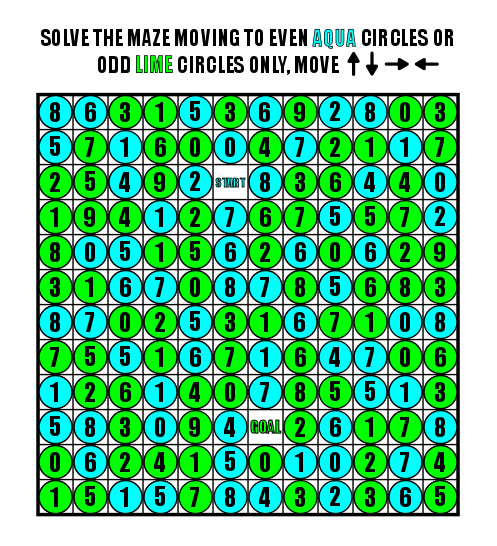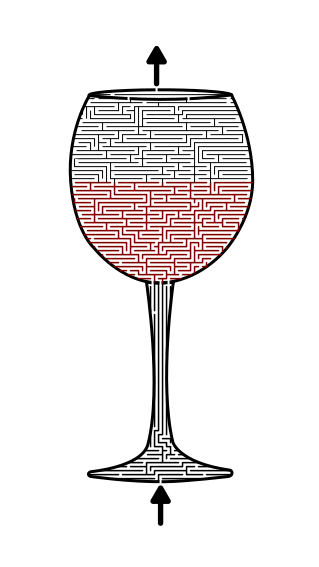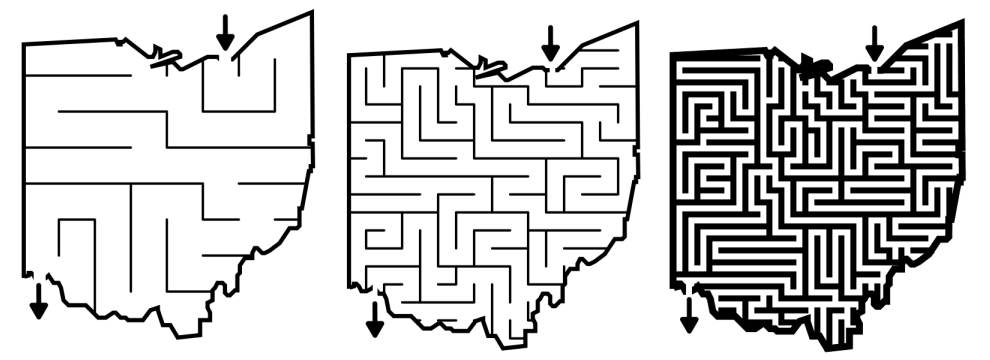Welcome to Part 2 of my 3 part series on maze construction options. Previously, I gave you step by step instructions to make 40 different maze constructions. But making a maze also means making a series of different decisions, each that will change the look and difficulty of the maze. If you missed Part 1, I suggest you start there !
Part 1 - Options for Starting and Ending a Maze
Part 2 - Maze Path options
Part 3 - Conditional Pathway options
Let’s get started with Part 2: Maze Path Options
In Part 1 you figured out how you will be starting and ending your maze. Today we will explore some options for how you make your pathways. Pathways are of course where the maze solver travels as they are moving thru the maze. We start with the most common:
1 - Walled pathway
The most common pathway you will find. Self explanatory to anyone who has ever done a maze and most people that haven’t. The solver travels between walls made of lines. Here is what it looks like:
2 - On Line Pathway
On line pathways are exactly as described - the solver travels on the lines and not in between them. This defines what an On Line Maze is, but can also used for Directional Mazes, which would have instructions such as - solve this maze by only turning left. Here is an example of an On Line Maze. If a solver is not paying attention, they may try to solve this maze as if it was using walls. If you use this construction I suggest adding directions explaining the “on-line” aspect.
3 - Weaving Paths
Weaving Paths are intertwined and allow the solver to travel over/under other paths within the maze. Some use shadows or arrows to better define the movement and enhance the look of the maze, but generally it looks like below:
4 - Themed Pathways
This category is a catch all for a variety of themed pathways you find and become common in children’s maze and activity books. Some examples of these include Railroad tracks, a Roadway, a Subway Line, Sidewalks, and Pipes. Really places where people would naturally travel, or in the case of Pipes, water would. Here is a pipe maze example (which happens to also be a weaving pathway). Notice that I used shadows to further define the weaving aspect.
5 - Grid “Pathway”
Grids can used for regular mazes, but are most commonly used in the different types of Puzzle Mazes. Puzzle Mazes, Block Move Mazes, Number Mazes, Letter Mazes, all use grids to give them structure. Below is a Standard Grid Maze and a Puzzle Maze to show 2 different variations of how grids can be used:
6 - Arrow Mazes
While Arrow Maze and Slide Arrow Mazes both use a grid for structure, the pathway you are following is actually determined by the arrow you land on and the direction you choose along the way. I consider this more about the arrows than the grids they are in. Here is an Arrow Maze as an example:
7 - Free Drawn pathways
I say free drawn pathways, but really what you are drawing by hand are the walls. You get it. This encompasses all the variations that don’t quite fit into a perfect grid or grided path system. The distance between walls varies. Here is a crushed beer can (drawn digitally) with free drawn paths:
8 - Background Picture
Mazes can have backgrounds, some of which have nothing to do with solving the maze. Think of making a maze over a picture of something. You could use the border as the Maze, but internally the picture only helps to decorate the pathways. Here is my maze from National Book day for example:
9 - Objects as Walls/Paths
Similar to what I mentioned before above, this is really about creating pathways by what you use as walls. Using objects or words for the walls creates a very interesting path for the solver. I think they are fun to make and you can be very creative with it. Here are examples of pathways that were made using circles and many small boxes:
10 - Patterned walls
Drawing a standard maze with straight lines as walls can get boring for both the mazer and the solver. This can be made more interesting by using a pattern that repeats for the walls. Like a simple back and forth, or a curve. Notice the example below how a simple maze transforms when drawn with standard walls versus with patterned walls. Very different looks for the same maze.
11 - Colored Paths (walls)
There is an option to enhance the maze you have made using colored walls to define sections. It is much more common to see color used as a background, but keeping this as an option can really enhance your maze making. The example shows a wine maze, specifically a red wine maze as defined by the colored walls ! You might want to read about a case study on colored pathways.
12 - Path Spacing
While most pathways you come across will be walled, there are different looks achieved ( and different maze types resulting from) based on how the same lines are spaced. In the examples below we have walled mazes used to maze the same object with 3 different looks. #1 is a Kids maze with highly spaced walls. #2 is a standard maze with normally spaced walls. #3 is a standard equal where the walls are pathways are of equal width.
And while this is not the best example, below is a design that used different path widths for each different section of the object. I should mention that the background color is the same in every section. Notice how the bishop has a very dark colored head because of the closer pathways with a lighter core section. Line spacing is a great way to change the color and shading of an object you are mazing !
13 - Use the Drawing as Walls (Natural shape of the subject)
When making maze art I find that the best looking mazes are ones where I don’t create any pathways, but where the pathways are naturally created by the object I am making a maze of. Typically this involves the draw and cut method of maze making where I draw something, then cut a maze into the structure. Almost every building maze on this site uses that method. In the example below of Museo Soumaya the panels of the building become the walls. Panels, bricks, windows, they all have become pathway makers for me !
Additional Posts on Maze making you may like:
Using Color for Maze Pathways - A Case Study
Maze Design Case Study - Designing a Grid Maze in Different Difficulty levels
Check out my YouTube channel to see maze art being made !
















